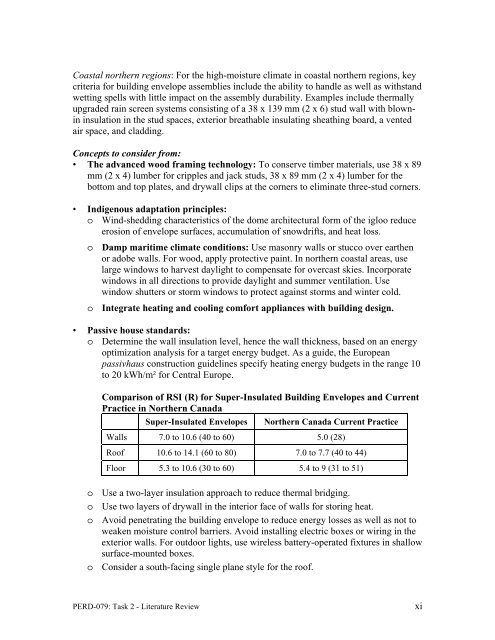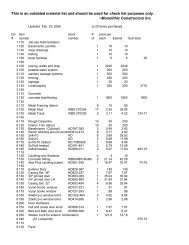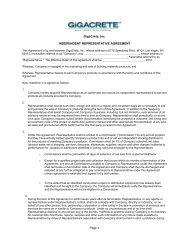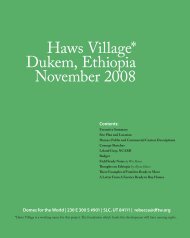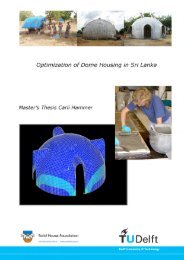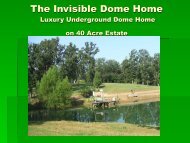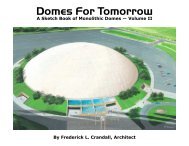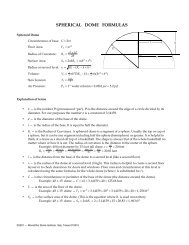Literature Review on Building Envelope, Heating and ... - Beeshive.org
Literature Review on Building Envelope, Heating and ... - Beeshive.org
Literature Review on Building Envelope, Heating and ... - Beeshive.org
Create successful ePaper yourself
Turn your PDF publications into a flip-book with our unique Google optimized e-Paper software.
Coastal northern regi<strong>on</strong>s: For the high-moisture climate in coastal northern regi<strong>on</strong>s, key<br />
criteria for building envelope assemblies include the ability to h<strong>and</strong>le as well as withst<strong>and</strong><br />
wetting spells with little impact <strong>on</strong> the assembly durability. Examples include thermally<br />
upgraded rain screen systems c<strong>on</strong>sisting of a 38 x 139 mm (2 x 6) stud wall with blownin<br />
insulati<strong>on</strong> in the stud spaces, exterior breathable insulating sheathing board, a vented<br />
air space, <strong>and</strong> cladding.<br />
C<strong>on</strong>cepts to c<strong>on</strong>sider from:<br />
• The advanced wood framing technology: To c<strong>on</strong>serve timber materials, use 38 x 89<br />
mm (2 x 4) lumber for cripples <strong>and</strong> jack studs, 38 x 89 mm (2 x 4) lumber for the<br />
bottom <strong>and</strong> top plates, <strong>and</strong> drywall clips at the corners to eliminate three-stud corners.<br />
• Indigenous adaptati<strong>on</strong> principles:<br />
o Wind-shedding characteristics of the dome architectural form of the igloo reduce<br />
erosi<strong>on</strong> of envelope surfaces, accumulati<strong>on</strong> of snowdrifts, <strong>and</strong> heat loss.<br />
o Damp maritime climate c<strong>on</strong>diti<strong>on</strong>s: Use mas<strong>on</strong>ry walls or stucco over earthen<br />
or adobe walls. For wood, apply protective paint. In northern coastal areas, use<br />
large windows to harvest daylight to compensate for overcast skies. Incorporate<br />
windows in all directi<strong>on</strong>s to provide daylight <strong>and</strong> summer ventilati<strong>on</strong>. Use<br />
window shutters or storm windows to protect against storms <strong>and</strong> winter cold.<br />
o Integrate heating <strong>and</strong> cooling comfort appliances with building design.<br />
• Passive house st<strong>and</strong>ards:<br />
o Determine the wall insulati<strong>on</strong> level, hence the wall thickness, based <strong>on</strong> an energy<br />
optimizati<strong>on</strong> analysis for a target energy budget. As a guide, the European<br />
passivhaus c<strong>on</strong>structi<strong>on</strong> guidelines specify heating energy budgets in the range 10<br />
to 20 kWh/m² for Central Europe.<br />
Comparis<strong>on</strong> of RSI (R) for Super-Insulated <strong>Building</strong> <strong>Envelope</strong>s <strong>and</strong> Current<br />
Practice in Northern Canada<br />
Super-Insulated <strong>Envelope</strong>s Northern Canada Current Practice<br />
Walls 7.0 to 10.6 (40 to 60) 5.0 (28)<br />
Roof 10.6 to 14.1 (60 to 80) 7.0 to 7.7 (40 to 44)<br />
Floor 5.3 to 10.6 (30 to 60) 5.4 to 9 (31 to 51)<br />
o Use a two-layer insulati<strong>on</strong> approach to reduce thermal bridging.<br />
o Use two layers of drywall in the interior face of walls for storing heat.<br />
o Avoid penetrating the building envelope to reduce energy losses as well as not to<br />
weaken moisture c<strong>on</strong>trol barriers. Avoid installing electric boxes or wiring in the<br />
exterior walls. For outdoor lights, use wireless battery-operated fixtures in shallow<br />
surface-mounted boxes.<br />
o C<strong>on</strong>sider a south-facing single plane style for the roof.<br />
PERD-079: Task 2 - <str<strong>on</strong>g>Literature</str<strong>on</strong>g> <str<strong>on</strong>g>Review</str<strong>on</strong>g><br />
xi


